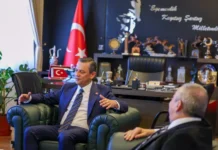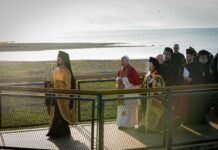[12th May 2021] This is a good opportunity for an exercise in historical thinking. Or, shall we say, critical thinking applied to history. In everyday conversation, lots of people say this or that about history. What matters is not who said it but what was said. You may not know much about this particular subject. Nevertheless, you don’t feel very comfortable with the statement. Even if you cannot immediately say wheher it is true or false, is it at least plausible — more or less in line with “the limits of the possible” at the time? Could it really have happened that way? Or, sensational as it may sound, is it fundamentally flawed? Repeated for generations, has it become so folkloric as to prevent us from questioning it?
I once had a history teacher who would tell us tall tales in class about the Ottoman wars in Hungary. These Hungarian or Austrian knights, he said, had swords that were 5 metres long which they would keep whirling in huge circles around their heads, mowing down everything in their way. But how much would it have weighed? Of course when I was in my mid-teens I was not aware of all the details below. But I am still a bit abashed because this key question did not even occur to me. — Medieval single-handed swords, in use over 1000-1500, were around 90 cm overall (including the hilt or pommel). What came to be called long-swords, with long-hilts allowing for a two-handed grip, with just the blade averaging 90-110 cm, reached a maximum of 130 cm and weighed around 2 kilograms. Although no such thing as a 5-metre sword ever existed, if it had it would have been at least 8 kg. Leave aside the question of whether, extended to 5 metres, the blade would still be rigid or tend to sag. Also leave aside the question of how anybody might have carried a 5-metre sword (in what sort of scabbard) attached to his belt. Just think of this: How do you keep swinging something that long and heavy (where the centre of gravity is way out beyond your hand) in actual combat?
Now for a second and much more current example: What does “Anadolu” mean? Where does it come from? Of course it is the Turkish equivalent of the English “Anatolia.” But which led to which? Or could both be translations of a third word in some other language? Alternatively, is it possible or plausible that the Turkish word came first? That, moreover, it was originally a combination of two other Turkish words, ana for mother and dolu for full, so that ana+dolu = Anadolu must mean “land of mothers” or “a land full of mothers”? Could it have arisen in this way, and then passed into all other languages? That it therefore reflects the importance and respect accorded to motherhood in Turkish culture?
This interpretation is not very new. It goes back at least ninety years and to a not very nice kind of precedent: the Kemalist Cultural Revolution of the 1930s, and the unhealthy environment it created for a state-ordained hyper-nationalism.
Not every revolution begets a cultural revolution. Upheaval in politics, society, and the economy does not necessarily extend to culture, and entail a total break with the past in that sphere. This is much more difficult, and hence more ultra, than all other aspects of revolutions. The French Jacobins tried, adopting a new calendar beginning with the 1792 proclamation of the Republic as its zero point. They went even further, presuming to replace Christianity with a new Supreme Being and a new religion. In China, Mao also tried, launching the Great Proletarian Cultural Revolution, so-called, over 1966-1976. It proposed, in somewhat mystical tones, to “eradicate all sources of individualism and egotism in the human soul” so as to “forever prevent revisionism from coming to power and restoring capitalism.” The bottom line was much more realistic. It amounted to a vindictive purge of Mao’s top Communist Party rivals by unleashing street populism and mob violence. The economy went into a tailspin. Major massacres by the Red Guards, production stoppages, supply chain breakdowns, famine, and the draconian conditions of forced labor imposed on students and intellectuals who were sent to rural areas in order to “get proletarianized,” may have claimed as many as 20 million lives.
Neither was Kemalism able to evade a comparable revolutionist extreme, though of a more armchair sort. In going from Empire to Republic, it tried to forge a new modernist nation-state identity and affinity. Islam was not wanted. The Ottoman past was not wanted. Ankara was to be counterposed to Istanbul. The Society for Research on Turkish History (later the TTK, the Turkish Historical Society) counterposed to the Committee on Ottoman History (my italics). The Turks had to be associated with Europe and the West through both racial and civilizational arguments. Last but not least, Anatolia had to be shown to have belonged to “us” from time immemorial. All of which implied creating a new past conforming to the new present — hence a whole new theory of history.
It looked doable, because, after all, it was the One Party era. (Now this is a euphemism if ever there was one. We say “One Party” and then add “era” to complete the noun clause, because for some reason we cannot say “dictatorship.” As if there could also be a One Party democracy.) Secularism had already turned authoritarian in the 1920s, and became even more so over the next decade. In 1932 mosques were forbidden to chant the call to prayers (the ezan or adhan) in Arabic. All religious belief and worship was heavily repressed. The state radio no longer broadcast alla turca music. After 1915 and the Turkish-Greek population exchange decided at Lausanne, ethnic cleansing spread from demography to language and place names. The Pure Turkish movement, so-called, targeted especially words of Arabic or Persian origin.
It was all topped by the Sun Theory of Language and the Turkish Thesis of History. According to the latter, once upon a time there had been a very very ancient Turkish civilization in Central Asia — prior to 7000 BC. It was (baselessly) said to have been Turkish. It was also (and equally baselessly) said to have been civilized — even more, the very first civilization on Earth. Then, however, the climate changed, a new desert-and-steppe environment made agriculture impossible, and emigration began. Those who stayed behind reverted to nomadism. Those who left spread all over the world, taking a superior race (?!), a pure blood (?!), and a high civilization wherever they went. (When I was small, there was a map of “The Turks’ Motherland and Routes of Migration” that was never taken back to my primary school’s map room but used to hang all the time to the front-right of the blackboard. From a dark pink blob in Central Asia, thick red arrows radiated in all directions. Faithfully reproduced in all period textbooks, too, it was considerably simpler and cruder than the more recent yet still mythical version you see at the very top.) These Turkish movements starting c.7000 BC meant, among other things, that “we” had entered Anatolia not after AD 1071 but much earlier, like the 2nd millennium BC. Atatürk, indeed, had explicitly stated that Turks could not be regarded as the real masters of this country if it were to be admitted that they had arrived only in the 11th century. He had directed Afet İnan to work on this problem (you can check my Cumhuriyet İdeolojisi ve Fuat Köprülü [Republican Ideology and Fuat Köprülü] for a more extended summary). A solution (of sorts) was provided by the Hittites, who were now said to have been Turkish, and who came to be re-named as the Eti Turks. And of course the Sumerians in Mesopotamia, too, were Turkish, since, together with the Hittite language, Sumerian was also (totally baselessly) identified as a Turkic language. Two state economic enterprises were set up to enshrine this fabricated connection: Etibank and Sümerbank, as well as, in the private sector, the Eti Biscuits company.
Up to a point, we can understand (but not sympathize with) their concerns. This legendary Central Asian civilization enabled them to bypass both Islam and the Ottomans, while with the Hittites they appeared to have made Anatolia “our own” at a time when there were no Greeks around. But it was all junk, a pile of rubbish, devoid of any scientific foundation whatsoever. Even worse was the rude intervention of politics in history. The Great Leader’s personal orders resulted in utter disregard for scientific methodology. The academic world’s need and ability to evolve by its own internal rules and procedures was crushed underfoot. What was encouraged and promoted was not genuine scholarship but loyalty to the state. It had a corrosive, debilitating, immoral, unethical impact. It was no coincidence that the rise of the Turkish Thesis of History and the Turkish Historical Society went hand in hand with the University Reform of 1933. This was another innocent-sounding euphemism for a comprehensive purge of Istanbul University — of elements that were considered to be out of tune with the ideological requirements of the Kemalist régime.
And it was within this overall framework, and with a kind of crass arrogance that can only result from a combination of ignorance with untouchable power, that various amateur linguists who had made their way into Atatürk’s close circle began to vie with one another in proposing word-meanings intended to bolster the Turkish Thesis of History. From that evening table, the famous sofra of Kemalist lore and legend, a virtual hysteria rose and spread to the rest of the elite. Such spasms have marked many hyper-nationalist dictatorial cultures. The time, too, was auspicious: Fascism and Nazism were on the rise; Mussolini had already come to power in 1922, and Hitler was about to do so in 1933. Trolls flourished, and some unbelievable etymologies were concocted, all the way to Ancient Greek gods and goddesses. Turks and Turkish seemed to have been everywhere, naming everything, including South and North America. Hence the Amazon came to be derived from amma+uzun (how long it is), the Niagara Falls from ne+yaygara (how noisy it is), and Apollon from alp+oğlan (noble youth). It was as part of that madness that the ana+dolu = Anadolu construction also emerged and rose above all else, making its way into fairy tales, ditties, children’s prose and poetry.
Now from all this, back to what I said in the beginning about historical thinking, or critical thinking applied to history. Swept along by a tide of irrationalism, the Kemalist apparatchiki (Soviet slang for obedient party men) who can be credited with having gifted this poisonous legacy to later generations did not stop to think of some very simple, very basic questions like the following (which, to repeat, did not and do not require any previous information background): So the Turks came into a new land, perceived it to be full of mothers, and hence named it ana+dolu = Anadolu, eh? But what was it called before them? (Let’s put the Hittites or Eti Turks to one side, for, paradoxically, this ana+dolu derivation is compatible only with 1071 and its aftermath.) Did this geography have no older name? Was there nobody living in this rectangular peninsula jutting out into the Mediterranean? Was there no state? Who or what was it that had been defeated at Malazgirt? Byzantium, did you say? So how were these territories referred to in Byzantine provincial administration, land tenure, or frontier defences?
Alas. But let’s move forward by assuming that even if it might have had a name, it remains unknown to us. For the moment, let us also leave aside just how place names are really and truly created in history. In order for this sort of new term to have been invented from scratch, as a minimum logical condition the host country must have had this or that feature that appeared strange and striking to the invaders or immigrants. So did the Turks perceive their new country to be uniquely full of mothers? In general, human populations are fairly evenly divided between men and women. Here, was it any different? Compared with other countries, such as where they were coming from, whether it was Transoxiana, or the region around Merv and Dandanakan, or Horasan or Azerbaycan, did they encounter such a significantly higher proportion of mothers here, that they were so impressed as to start talking (not there but here) about ana+dolu? And also, just when, how, and by who was this decision ultimately made? As Byzantium’s eastern defences collapsed, more and more Turcoman tribes made their way through Azerbaycan to establish new homelands (il or yurt) for themselves in former Roman territory. It was not a unified, centralized invasion but a much more diverse and fragmented kind of wave under various tribal or semi-tribal war-leaders. Just who among them might have had this ana+dolu brainwave? How, then, would he have made it stick? By convening an assembly and getting everyone else to agree? Would they have cared the slightest bit about such nomenclature, such modern cognitive and classificatory problems? But even if we hypothesize that they did, just where and when did it happen? And where might we find it in our sources or primary documents?
This should be more than enough of beating a dead dog. Of course, nothing of the sort ever happened. From the moment of their 11th century irruption, the Turks imparted only a single name to this country: Türkiye. And that was not a conscious decision, a deliberate act of naming, but the product of spontaneous developments — a massive demographic and linguistic change which happened to be observed and reported by outsiders. In proper scholarly methodology, historians proceed from identifying languages to peoples’ names (ethnonyms) to place names (toponyms). I teach this in SPS 101-102, in HIST 213, HIST 323 and HIST 325, also in HIST 503-504 and 505-506 (graduate-level world history and historiography). As well as in HIST 572 (From Republic to Empire). Where the ancient Britons settled comes to be called Britannia; where the ancient Germans settled comes to be called Germania; where the Slavs’ Rus’ branch settled comes to be called Russia. So with the Turks. Their arrival changed the human composition of, shall we say, Asia Minor to such an extent that it came to be noted by Italian (primarily Venetian and Genoese) merchants — who were well-established not only in Constantinople but also in the Aegean islands as well as all along the Ageean and Black Sea coastline. They were constantly trading with the interior, and it was they who first coined Turchia in the 12th century to denote what had become “the land where the Turks live.” From Italian it quickly passed into other European languages as Turkey, Turquie, Turkei. But the Turks themselves, or rather their ruling elites, whether as the Konya Sultanate or the Ottomans, did not use this word until the 19th century. For them it long remained Diyar-ı Rûm, the lands of Rome, the Roman empire.
Meanwhile, where is Anatolia in all this? It was always there; together with Asia Minor, referred to above, it had been one of two place names traditionally applied to this geography over the previous two thousand years. And it has continued intact over the next millennium, down to this day. What the Turkish Thesis of History people did not like about it was that it was a Greek word meaning the east, or where the sun rises. But let’s leave that for tomorrow.
For the original posting of this article, click https://hist.ihu.edu.tr/en/halil-berktays-diary/.













